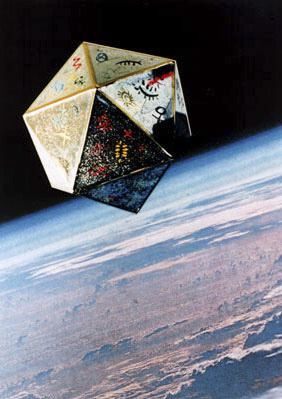Project Background

Artist Concepts of the O.U.R.S. 2000 and the OUR-SPS
In the mid-1980's, Arthur Woods initiated the Orbiting Unification Ring Satellite - O.U.R.S project with the goal to create a visible "circle in the sky" to celebrate the advent of the new millennium. It was planned that the O.U.R.S sculpture would be launched into orbit in the year 2000.
The O.U.R.S. sculpture was technically defined to be a continuous toroidal structure with a crown diameter of one kilometer and a ring thickness of approximately 30 meters in diameter. This definition was based on a technology called ISRS (Inflatable Space Rigidized Structures) which was under development at the time by the European Space Agency (ESA) via the Swiss space firm Contraves Space AG. Once launched into space and placed into orbit, the O.U.R.S would be automatically deployed by inflation and the membrane of the sculpture - a laminate of Kevlar, Kapton and an ultra-violet sensitive resin - would harden upon exposure to sunlight and become rigid. When fully deployed, the sculpture would appear to viewers around the world in the early morning or early evening sky and would be visible to the naked eye as a recognizable circle approximately one-quarter the size of the Moon.
In 1990, the OURS Foundation was founded by Arthur Woods with the primary purpose to introduce, nurture and expand a cultural dimension to humanity's astronautical endeavors. Dr. Marco C. Bernasconi, who was head of R&D for the ISRS technology program at Contraves, became vice-president and the technical advisor for the O.U.R.S. project about this time. In the development of the project, we planned to realize a smaller "prototype" version of the O.U.R.S. sculpture in order to test both the concept and the technology. Contraves Space AG had developed a six-meter ISRS torus for testing purposes. As most of the technical design work had already been done, we proposed to Contraves to build a similar structure for our prototype project which was called the OUR-Space Peace Sculpture - OUR-SPS. The form of the sculpture was a circle divided by a cross supporting a small sphere in the center. The OUR-SPS had a diameter of 6 meters and a ring thickness of 20 centimeters. The outer covering of the sculpture was to be printed with the word "peace" in all of the world's languages.
On February 25, 1988 a "letter of intent" was signed with Glavcosmos and their commercial agent V/O Licensintorg of the U.S.S.R. to launch the sculpture to the Mir space station and to deploy it by ejection. Our goal was to help celebrate The International Space Year (ISY) in 1992 with a sign and symbol of peaceful, international cooperation in space. Unfortunately, Contraves was unable to provide their technology for this mission. However, a full size working model of the inflatable sculpture was then built by NPO Energia of Moscow and delivered in March 1990. The technology utilized by NPO Energia had been previously used on an inflatable toroidal antenna with a diameter of 20 meters which was deployed from the Progress 28 spacecraft in 1988. It was agreed by all parties that theOUR - Space Peace Sculpture would be deployed from the Mir space station during a spacewalk with the deployment sequence transmitted via live television to viewers on Earth. Unfortunately, organizational and financial uncertainties associated with the demise of the U.S.S.R. in 1991, led to the postponement and cancellation of this project as the 1992 ISY window of opportunity could not be met.
Later, the OURS Foundation introduced and successfully managed the spaceflight of two art projects to the Mir space station. The Cosmic Dancer sculpture which was designed to investigate the properties of sculpture in weightlessness and the advantages of integrating art into a space habitat was realized in 1993 and, in 1995, Ars Ad Astra - The 1st Art Exhibition in Earth Orbit comprised of twenty original art works and an electronic archive from an international group of artists was included in ESA's EUROMIR95 mission.

The Millennium SEED concept
However, during this time other concepts for using expandable membrane technology were introduced and developed. The Seeds Project (Synergizing Earth's Evolutionary Development Spacewards) began at the idea stage around 1990 and had a first public installation at the 46th International Astronautical Congress in Oslo (Norway) in October 1995. The SEEDS concept wished to initiate a realistic program to develop and send artistic payloads containing organic material into space. In 1997, it was proposed to scientists working on planned planetary missions to incorporate "SEEDS" payloads into their missions. The Millennium SEED would have involved a large inflatable object in the form of a icosahedron placed in Earth orbit. It was designed to be visible to all humanity as a blinking star and then to return to Earth a thousand years from now carrying with it the "seeds" of our time -- in case it become necessary to "re-seed" Earth in order to maintain life in this part of the cosmos - a clear and permanent statement that humanity's future on Earth is irrevocably linked to its future in space.
In 2003, the European Space Agency contracted the OURS Foundation to re-examine the technology for large expandable structures for cultural purposes in light of any new technological developments. In the course of this study, the icosahedron form was looked at in more technical detail and utilizing the technology now called CRES (Chemically Rigidized Expandable Structures) payload mass and visibility parameters were established. In 2008, the idea of incorporating Space Solar Power elements and other interactive technologies were introduced. The Space Option Star is a synthesis of the most recent developments of this concept.
See also:
Inflatable Technologies for Sculpture in Earth Orbit
